Working with Conditional Formatting
14 Mar 202324 minutes to read
Conditional formatting allows to format the contents of a cell dynamically. This can be defined and applied in XlsIO through the ConditionalFormat class.
Create a Conditional Format
The ConditionalFormats represents a collection of conditional formats for a single or multiple Range. One or more conditional formats can be added to the range as follows.
//Applying conditional formatting to "A1".
final ConditionalFormats conditions =
sheet.getRangeByName('A1').conditionalFormats;
final ConditionalFormat condition1 = conditions.addCondition();The target range should meet the criteria, which is set using the ConditionalFormat class. The desired format type is set through the ExcelCFType enumerator, which are the supported conditional format types in XlsIO. Refer to the following code.
//Represents conditional format rule that the value in target range should be between 10 and 20
condition1.formatType = ExcelCFType.cellValue;
condition1.operator = ExcelComparisonOperator.between;
condition1.firstFormula = '10';
condition1.secondFormula = '20';
sheet.getRangeByIndex(1, 1).setText('Enter a number between 10 and 20');When the criteria set for the target range is satisfied, the defined formats (like the one below) are applied in the order of priority. For more details about conditional format priority, see Manage conditional formatting rule precedence.
//Setting format properties to be applied when the above condition is met
//set back color by hexa decimal.
condition1.backColor = '#209301';
condition1.isBold = true;
condition1.isItalic = true;The following code creates and applies various different conditional formats for different ranges in XlsIO.
// Create a new Excel Document.
final Workbook workbook = Workbook();
// Accessing sheet via index.
final Worksheet sheet = workbook.worksheets[0];
//Applying conditional formatting to "A1".
ConditionalFormats conditions = sheet.getRangeByName('A1').conditionalFormats;
final ConditionalFormat condition1 = conditions.addCondition();
//Represents conditional format rule that the value in target range should be between 10 and 20
condition1.formatType = ExcelCFType.cellValue;
condition1.operator = ExcelComparisonOperator.between;
condition1.firstFormula = '10';
condition1.secondFormula = '20';
sheet.getRangeByIndex(1, 1).setText('Enter a number between 10 and 20');
//Setting format properties to be applied when the above condition is met.
//set back color by hexa decimal.
condition1.backColor = '#66FF99';
//set font color by hexa decimal.
condition1.fontColor = '#448EBC';
//set font bold.
condition1.isBold = true;
//set font italic.
condition1.isItalic = true;
//Applying conditional formatting to "A3".
conditions = sheet.getRangeByName('A3').conditionalFormats;
final ConditionalFormat condition2 = conditions.addCondition();
//Represents conditional format rule that the cell value should be 100.
condition2.formatType = ExcelCFType.cellValue;
condition2.operator = ExcelComparisonOperator.equal;
condition2.firstFormula = '100';
sheet.getRangeByIndex(3, 1).setText('Enter the Number as 100');
//Setting format properties to be applied when the above condition is met.
//set font color by hexa decimal.
condition2.fontColor = '#FF1574';
//set top border line style.
condition2.topBorderStyle = LineStyle.thick;
//set top border color by hexa decimal.
condition2.topBorderColor = '#FFCC00';
//set number format.
condition2.numberFormat = '0.0';
//Applying conditional formatting to "A5".
conditions = sheet.getRangeByName('A5').conditionalFormats;
final ConditionalFormat condition3 = conditions.addCondition();
//Represents conditional format rule that the cell value greater or equal to 50.
condition3.formatType = ExcelCFType.cellValue;
condition3.operator = ExcelComparisonOperator.greaterOrEqual;
condition3.firstFormula = '50';
sheet
.getRangeByIndex(5, 1)
.setText('Enter the number value greater than or equal to 50.');
//Setting format properties to be applied when the above condition is met.
//set back color by RGB values.
condition3.backColorRgb = Color.fromARGB(255, 150, 200, 50);
//set font color by RGB values.
condition3.fontColorRgb = Color.fromARGB(255, 200, 20, 100);
//set font underline
condition3.underline = true;
//set right border line style
condition3.rightBorderStyle = LineStyle.double;
// set right border color by RGB values.
condition3.rightBorderColorRgb = Color.fromARGB(240, 24, 160, 200);
//set bottom border line style
condition3.bottomBorderStyle = LineStyle.thin;
// set bottom border color by RGB values.
condition3.bottomBorderColorRgb = Color.fromARGB(255, 240, 160, 200);
//save and dispose.
final List<int> bytes = workbook.saveSync();
File('ConditionalFormatting.xlsx').writeAsBytes(bytes);
workbook.dispose();NOTE
The conditional formats for a single range should be added in descending order in Flutter XlsIO.
When proper criteria is met, the output file looks as follows:
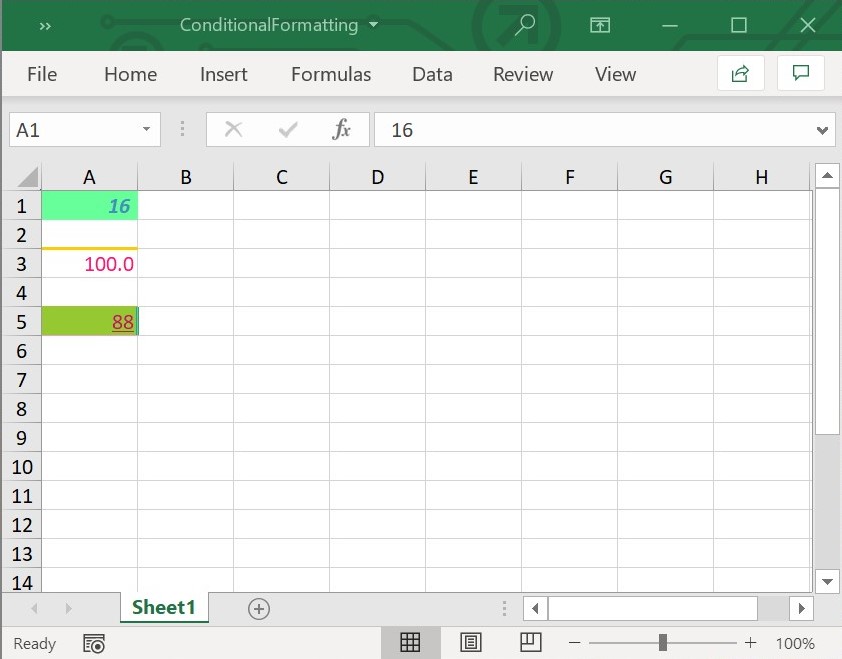
Using FormulaR1C1 property in Conditional Formats
Flutter XlsIO sets the formula for the conditional format in R1C1-style notation.
The following code example illustrates this.
// Create a new Excel Document.
final Workbook workbook = Workbook();
// Accessing sheet via index.
final Worksheet sheet = workbook.worksheets[0];
sheet.getRangeByIndex(1, 1).setNumber(123);
sheet.getRangeByIndex(2, 1).setNumber(23);
sheet.getRangeByIndex(3, 1).setNumber(25);
sheet.getRangeByIndex(4, 1).setNumber(5);
sheet.getRangeByIndex(5, 1).setNumber(44);
sheet.getRangeByIndex(6, 1).setNumber(2);
sheet.getRangeByIndex(7, 1).setNumber(67);
sheet.getRangeByIndex(8, 1).setNumber(92);
sheet.getRangeByIndex(9, 1).setNumber(68);
sheet.getRangeByIndex(10, 1).setNumber(84);
//Applying conditional formatting to "A1:D4".
final ConditionalFormats conditions =
sheet.getRangeByName('A1:D4').conditionalFormats;
final ConditionalFormat condition1 = conditions.addCondition();
condition1.formatType = ExcelCFType.cellValue;
condition1.operator = ExcelComparisonOperator.between;
condition1.firstFormulaR1C1 = '=R[1]C[0]';
condition1.secondFormulaR1C1 = '=R[8]C[0]';
//save and dispose.
final List<int> bytes = workbook.saveSync();
File('FormulaR1C1.xlsx').writeAsBytes(bytes);
workbook.dispose();Format Specific Text
Specific text Conditional Formatting is used to format the Excel range contains given text using ExcelCFType enumeration and text property.
The below code example shows how to format specific text using conditional formatting in Flutter XlsIO.
// create a Excel document.
final Workbook workbook = Workbook();
// Accessing sheet via index.
final Worksheet sheet = workbook.worksheets[0];
// Applying conditional formatting.
final ConditionalFormats conditions =
sheet.getRangeByName('A1:A10').conditionalFormats;
final ConditionalFormat condition1 = conditions.addCondition();
condition1.formatType = ExcelCFType.specificText;
condition1.operator = ExcelComparisonOperator.containsText;
condition1.text = 'm';
condition1.backColor = '#00FF99';
condition1.fontColor = '#CE2622';
condition1.isItalic = true;
condition1.isBold = true;
condition1.underline = true;
condition1.bottomBorderStyle = LineStyle.medium;
condition1.bottomBorderColor = '#FB5825';
condition1.topBorderStyle = LineStyle.double;
condition1.topBorderColor = '#CCFD31';
condition1.rightBorderStyle = LineStyle.thick;
condition1.rightBorderColor = '#A44C9A';
condition1.leftBorderStyle = LineStyle.thin;
condition1.leftBorderColor = '#CC00CC';
// Setting value in the cell.
sheet.getRangeByIndex(1, 1).setText('John');
sheet.getRangeByIndex(2, 1).setText('James');
sheet.getRangeByIndex(3, 1).setText('Anne');
sheet.getRangeByIndex(4, 1).setText('Jai');
sheet.getRangeByIndex(5, 1).setText('Harish');
sheet.getRangeByIndex(6, 1).setText('Dinesh');
sheet.getRangeByIndex(7, 1).setText('Avnish');
sheet.getRangeByIndex(8, 1).setText('Yamini');
sheet.getRangeByIndex(9, 1).setText('Kani');
sheet.getRangeByIndex(10, 1).setText('Anu');
//save and dispose.
final List<int> bytes = workbook.saveSync();
File('CFSpecificText.xlsx').writeAsBytes(bytes);
workbook.dispose();The following screenshot represents generated Excel file with specific text conditional format in Flutter XlsIO.

Format Date Occurring
Date occurring Conditional Formatting is used to format the Excel range contains given date using ExcelCFType and CFTimePeriods enumeration.
The below code example shows how to format date occurring conditional formatting in Flutter XlsIO.
// create a Excel document.
final Workbook workbook = Workbook();
// Accessing sheet via index.
final Worksheet sheet = workbook.worksheets[0];
// Applying conditional formatting.
final ConditionalFormats conditions =
sheet.getRangeByName('A1:A10').conditionalFormats;
final ConditionalFormat condition = conditions.addCondition();
//Represents conditional format rule that the date occurring contains yesterday.
condition.formatType = ExcelCFType.timePeriod;
condition.timePeriodType = CFTimePeriods.yesterday;
//Setting format properties to be applied when the above condition is met.
condition.backColor = '#FFFF00';
condition.fontColor = '#FF33CC';
condition.isItalic = true;
condition.isBold = true;
condition.underline = true;
condition.bottomBorderStyle = LineStyle.medium;
condition.bottomBorderColor = '#2F2BD3';
condition.topBorderStyle = LineStyle.double;
condition.topBorderColor = '#44BA9B';
condition.rightBorderStyle = LineStyle.thick;
condition.rightBorderColor = '#663300';
condition.leftBorderStyle = LineStyle.thin;
condition.leftBorderColor = '#823B89';
condition.numberFormat = 'd-mmm';
// Setting value in the cell.
final now = DateTime.now();
sheet
.getRangeByIndex(1, 1)
.setDateTime(DateTime(now.year, now.month, now.day));
sheet
.getRangeByIndex(2, 1)
.setDateTime(DateTime(now.year, now.month, now.day - 1));
sheet
.getRangeByIndex(3, 1)
.setDateTime(DateTime(now.year, now.month, now.day));
sheet
.getRangeByIndex(4, 1)
.setDateTime(DateTime(now.year, now.month, now.day + 1));
sheet
.getRangeByIndex(5, 1)
.setDateTime(DateTime(now.year, now.month, now.day - 1));
sheet
.getRangeByIndex(6, 1)
.setDateTime(DateTime(now.year, now.month, now.day + 1));
sheet
.getRangeByIndex(7, 1)
.setDateTime(DateTime(now.year, now.month, now.day - 1));
sheet
.getRangeByIndex(8, 1)
.setDateTime(DateTime(now.year, now.month, now.day - 1));
sheet
.getRangeByIndex(9, 1)
.setDateTime(DateTime(now.year, now.month, now.day));
sheet
.getRangeByIndex(10, 1)
.setDateTime(DateTime(now.year, now.month, now.day + 1));
sheet.autoFitColumn(1);
//save and dispose.
final List<int> bytes = workbook.saveSync();
File('CFDateoccurring.xlsx').writeAsBytes(bytes);
workbook.dispose();The following screenshot represents generated Excel file with date occurring conditional format in Flutter XlsIO.

Format Unique and Duplicate Values
Format unique and duplicate values of an Excel range using conditional formatting. The values, Unique and Duplicate of the enumeration ExcelCFType helps to achieve the requirement.
The below code example shows how to format unique and duplicate values using conditional formatting in XlsIO.
// create a Excel document.
final Workbook workbook = Workbook();
// Accessing sheet via index.
final Worksheet sheet = workbook.worksheets[0];
// Setting value in the cell.
sheet.getRangeByIndex(1, 1).setText('Country');
sheet.getRangeByIndex(2, 1).setText('Northern America');
sheet.getRangeByIndex(3, 1).setText('Southern Europe');
sheet.getRangeByIndex(4, 1).setText('Eastern Africa');
sheet.getRangeByIndex(5, 1).setText('Oceania');
sheet.getRangeByIndex(6, 1).setText('Central Asia');
sheet.getRangeByIndex(7, 1).setText('Middle Africa');
sheet.getRangeByIndex(8, 1).setText('Southern Asia');
sheet.getRangeByIndex(9, 1).setText('Northern Africa');
sheet.getRangeByIndex(10, 1).setText('SouthEast Asia');
sheet.getRangeByIndex(11, 1).setText('The Caribbean');
sheet.getRangeByIndex(1, 2).setText('Internet Usage (%)');
sheet.getRangeByIndex(2, 2).setNumber(88);
sheet.getRangeByIndex(3, 2).setNumber(67);
sheet.getRangeByIndex(4, 2).setNumber(87);
sheet.getRangeByIndex(5, 2).setNumber(60);
sheet.getRangeByIndex(6, 2).setNumber(78);
sheet.getRangeByIndex(7, 2).setNumber(88);
sheet.getRangeByIndex(8, 2).setNumber(95);
sheet.getRangeByIndex(9, 2).setNumber(88);
sheet.getRangeByIndex(10, 2).setNumber(91);
sheet.getRangeByIndex(11, 2).setNumber(70);
sheet.autoFitColumn(1);
sheet.autoFitColumn(2);
// Applying conditional formatting.
final ConditionalFormats conditions =
sheet.getRangeByName('B1:B11').conditionalFormats;
final ConditionalFormat condition = conditions.addCondition();
//Represents conditional format rule that contains duplicate value.
condition.formatType = ExcelCFType.duplicate;
//Setting format properties to be applied when the above condition is met.
condition.backColor = '#FF8C53';
condition.isItalic = true;
condition.bottomBorderStyle = LineStyle.medium;
condition.bottomBorderColor = '#2F2BD3';
//save and dispose.
final List<int> bytes = workbook.saveSync();
File('CFUniqueDuplicate.xlsx').writeAsBytes(bytes);
workbook.dispose();The following screenshot represents generated Excel file with date occurring conditional format in Flutter XlsIO.
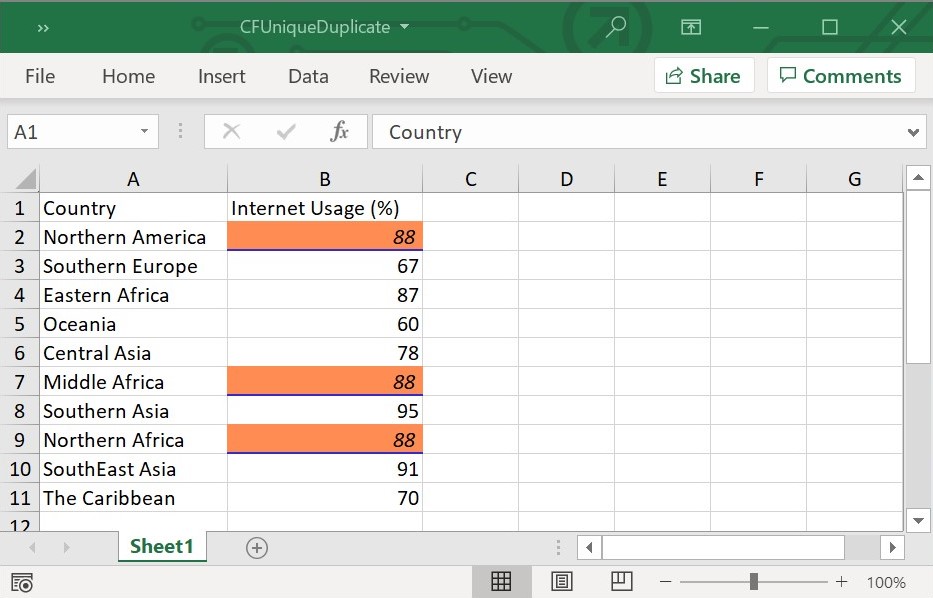
Format Top or Bottom Values
Top/Bottom rule in conditional formatting is used to highlight the top or bottom ranked cells in a data range. Top/Bottom conditional formatting rule can be created and customized using the TopBottom class in Flutter XlsIO.
The properties of TopBottom class are:
- type - Specifies whether the rank is evaluated from the top or bottom.
- percent - Specifies whether the rank is determined by a percentage value.
- rank - Specifies the maximum number or percentage of cells to be highlighted.
Top/Bottom ‘n’ rank Values
The below code example shows how to format top 8 rank values from the given data range using TopBottom type and rank properties in XlsIO.
// create a Excel document.
final Workbook workbook = Workbook();
// Accessing sheet via index.
final Worksheet sheet = workbook.worksheets[0];
// Setting value in the cell.
sheet.getRangeByIndex(1, 1).setText('Mark');
sheet.getRangeByIndex(2, 1).setNumber(29);
sheet.getRangeByIndex(3, 1).setNumber(13);
sheet.getRangeByIndex(4, 1).setNumber(88);
sheet.getRangeByIndex(5, 1).setNumber(98);
sheet.getRangeByIndex(6, 1).setNumber(60);
sheet.getRangeByIndex(7, 1).setNumber(69);
sheet.getRangeByIndex(8, 1).setNumber(49);
sheet.getRangeByIndex(9, 1).setNumber(100);
sheet.getRangeByIndex(10, 1).setNumber(19);
sheet.getRangeByIndex(11, 1).setNumber(80);
sheet.getRangeByIndex(12, 1).setNumber(60);
sheet.getRangeByIndex(13, 1).setNumber(89);
sheet.getRangeByIndex(14, 1).setNumber(23);
sheet.getRangeByIndex(15, 1).setNumber(75);
sheet.getRangeByIndex(16, 1).setNumber(89);
sheet.getRangeByIndex(17, 1).setNumber(37);
sheet.getRangeByIndex(18, 1).setNumber(59);
sheet.getRangeByIndex(19, 1).setNumber(39);
sheet.getRangeByIndex(20, 1).setNumber(79);
// Applying conditional formatting.
final ConditionalFormats conditions =
sheet.getRangeByName('A1:A20').conditionalFormats;
final ConditionalFormat condition = conditions.addCondition();
//Applying top or bottom rule in the conditional formatting.
condition.formatType = ExcelCFType.topBottom;
final TopBottom topBottom = condition.topBottom!;
//Set type as Top for TopBottom rule.
topBottom.type = ExcelCFTopBottomType.top;
//Set rank value for the TopBottom rule.
topBottom.rank = 8;
//Setting format properties to be applied when the above condition is met.
condition.backColor = '#934ADD';
condition.isBold = true;
//save and dispose.
final List<int> bytes = workbook.saveSync();
File('CFTopBottom.xlsx').writeAsBytes(bytes);
workbook.dispose();The following screenshot represents the Excel file generated with TopBottom conditional format with rank set to 8 in XlsIO.

NOTE
TopBottomrankvalue should be in a range between 1 and 1000.
Top/Bottom ‘n’% rank Values
The below code example shows how to format top 50 percentage rank values from the given data range using TopBottom type, rank and percent properties in XlsIO
// create a Excel document.
final Workbook workbook = Workbook();
// Accessing sheet via index.
final Worksheet sheet = workbook.worksheets[0];
// Setting value in the cell.
sheet.getRangeByIndex(1, 1).setText('Mark');
sheet.getRangeByIndex(2, 1).setNumber(29);
sheet.getRangeByIndex(3, 1).setNumber(13);
sheet.getRangeByIndex(4, 1).setNumber(88);
sheet.getRangeByIndex(5, 1).setNumber(98);
sheet.getRangeByIndex(6, 1).setNumber(60);
sheet.getRangeByIndex(7, 1).setNumber(69);
sheet.getRangeByIndex(8, 1).setNumber(49);
sheet.getRangeByIndex(9, 1).setNumber(100);
sheet.getRangeByIndex(10, 1).setNumber(19);
sheet.getRangeByIndex(11, 1).setNumber(80);
sheet.getRangeByIndex(12, 1).setNumber(60);
sheet.getRangeByIndex(13, 1).setNumber(89);
sheet.getRangeByIndex(14, 1).setNumber(23);
sheet.getRangeByIndex(15, 1).setNumber(75);
sheet.getRangeByIndex(16, 1).setNumber(89);
sheet.getRangeByIndex(17, 1).setNumber(37);
sheet.getRangeByIndex(18, 1).setNumber(59);
sheet.getRangeByIndex(19, 1).setNumber(39);
sheet.getRangeByIndex(20, 1).setNumber(79);
// Applying conditional formatting.
final ConditionalFormats conditions =
sheet.getRangeByName('A1:A20').conditionalFormats;
final ConditionalFormat condition = conditions.addCondition();
//Applying top or bottom rule in the conditional formatting.
condition.formatType = ExcelCFType.topBottom;
final TopBottom topBottom = condition.topBottom!;
//Set type as Top for TopBottom rule.
topBottom.type = ExcelCFTopBottomType.bottom;
//Set true to Percent property for TopBottom rule.
topBottom.percent = true;
//Set rank value for the TopBottom rule.
topBottom.rank = 50;
//Setting format properties to be applied when the above condition is met.
condition.backColor = '#934ADD';
condition.isItalic = true;
//save and dispose.
final List<int> bytes = workbook.saveSync();
File('CFTopBottomPercent.xlsx').writeAsBytes(bytes);
workbook.dispose();The following screenshot represents the Excel file generated with TopBottom conditional format with percent value set to 50 in Flutter XlsIO.
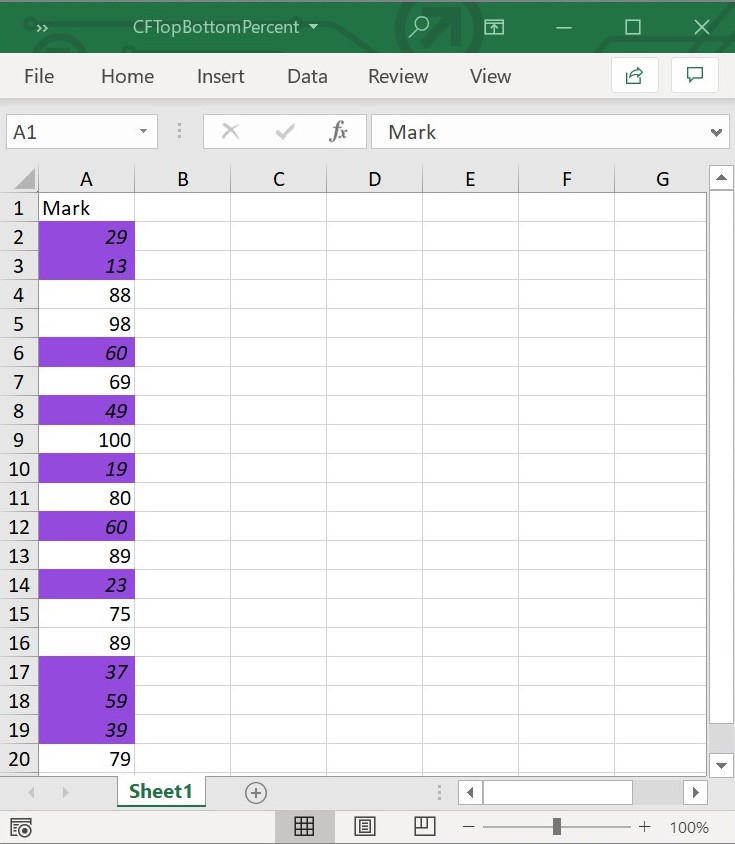
NOTE
TopBottomRankvalue should be in a range between 1 and 100 when set true toPercentproperty.
Format Above or Below Average Values
Above/Below average rule in conditional formatting is used to highlight the cells which contains above/below the average values in a data range. Above/Below conditional formatting rule can be created and customized using the AboveBelowAverage class in Flutter XlsIO.
The properties of AboveBelowAverage are:
- averageType - Specifies whether the conditional formatting rule looks for cell values that are above average or below average or standard deviation.
-
stdDevValue - Specifies standard deviation number for
AboveBelowAverageconditional formatting rule.
The below code example shows how to format a range with values that are below average using AboveBelowAverage AverageType property in XlsIO.
// create a Excel document.
final Workbook workbook = Workbook();
// Accessing sheet via index.
final Worksheet sheet = workbook.worksheets[0];
// Setting value in the cell.
sheet.getRangeByIndex(1, 1).setText('Mark');
sheet.getRangeByIndex(2, 1).setNumber(29);
sheet.getRangeByIndex(3, 1).setNumber(13);
sheet.getRangeByIndex(4, 1).setNumber(88);
sheet.getRangeByIndex(5, 1).setNumber(98);
sheet.getRangeByIndex(6, 1).setNumber(60);
sheet.getRangeByIndex(7, 1).setNumber(69);
sheet.getRangeByIndex(8, 1).setNumber(49);
sheet.getRangeByIndex(9, 1).setNumber(100);
sheet.getRangeByIndex(10, 1).setNumber(19);
sheet.getRangeByIndex(11, 1).setNumber(80);
sheet.getRangeByIndex(12, 1).setNumber(60);
sheet.getRangeByIndex(13, 1).setNumber(89);
sheet.getRangeByIndex(14, 1).setNumber(23);
sheet.getRangeByIndex(15, 1).setNumber(75);
sheet.getRangeByIndex(16, 1).setNumber(89);
sheet.getRangeByIndex(17, 1).setNumber(37);
sheet.getRangeByIndex(18, 1).setNumber(59);
sheet.getRangeByIndex(19, 1).setNumber(39);
sheet.getRangeByIndex(20, 1).setNumber(79);
// Applying conditional formatting.
final ConditionalFormats conditions =
sheet.getRangeByName('A1:A20').conditionalFormats;
final ConditionalFormat condition = conditions.addCondition();
//Applying above or below average rule in the conditional formatting.
condition.formatType = ExcelCFType.aboveBelowAverage;
final AboveBelowAverage aboveBelowAverage = condition.aboveBelowAverage!;
//Set AverageType as Below for AboveBelowAverage rule.
aboveBelowAverage.averageType = ExcelCFAverageType.below;
//Set color for Conditional Formattting.
condition.backColor = '#FF0D0D';
condition.fontColor = '#FFFFFF';
condition.isItalic = true;
condition.isBold = true;
//save and dispose.
final List<int> bytes = workbook.saveSync();
File('CFAboveBelowAverage.xlsx').writeAsBytes(bytes);
workbook.dispose();The following screenshot represents the Excel file generated with AboveBelowAverage conditional format with averageType set as below in Flutter XlsIO.
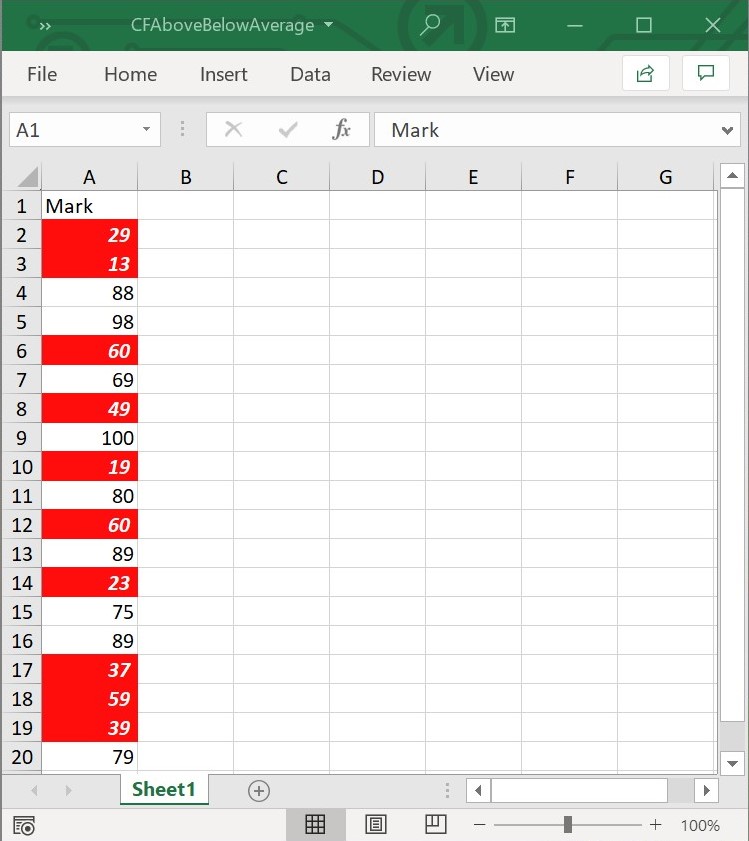
Above or Below Standard Deviation Values
The below code example shows how to format a range with values above standard deviation, using AboveBelowAverage averageType and stdDevValue properties in XlsIO.
// create a Excel document.
final Workbook workbook = Workbook();
// Accessing sheet via index.
final Worksheet sheet = workbook.worksheets[0];
// Setting value in the cell.
sheet.getRangeByIndex(1, 1).setText('Mark');
sheet.getRangeByIndex(2, 1).setNumber(29);
sheet.getRangeByIndex(3, 1).setNumber(13);
sheet.getRangeByIndex(4, 1).setNumber(88);
sheet.getRangeByIndex(5, 1).setNumber(98);
sheet.getRangeByIndex(6, 1).setNumber(60);
sheet.getRangeByIndex(7, 1).setNumber(69);
sheet.getRangeByIndex(8, 1).setNumber(49);
sheet.getRangeByIndex(9, 1).setNumber(100);
sheet.getRangeByIndex(10, 1).setNumber(19);
sheet.getRangeByIndex(11, 1).setNumber(80);
sheet.getRangeByIndex(12, 1).setNumber(60);
sheet.getRangeByIndex(13, 1).setNumber(89);
sheet.getRangeByIndex(14, 1).setNumber(23);
sheet.getRangeByIndex(15, 1).setNumber(75);
sheet.getRangeByIndex(16, 1).setNumber(89);
sheet.getRangeByIndex(17, 1).setNumber(37);
sheet.getRangeByIndex(18, 1).setNumber(59);
sheet.getRangeByIndex(19, 1).setNumber(39);
sheet.getRangeByIndex(20, 1).setNumber(79);
// Applying conditional formatting.
final ConditionalFormats conditions =
sheet.getRangeByName('A1:A20').conditionalFormats;
final ConditionalFormat condition = conditions.addCondition();
//Applying above or below average rule in the conditional formatting.
condition.formatType = ExcelCFType.aboveBelowAverage;
final AboveBelowAverage aboveBelowAverage = condition.aboveBelowAverage!;
//Set AverageType as AboveStdDev for AboveBelowAverage rule.
aboveBelowAverage.averageType = ExcelCFAverageType.aboveStdDev;
//Set value to StdDevValue property for AboveBelowAverage rule.
aboveBelowAverage.stdDevValue = 1;
//Set color for Conditional Formattting.
condition.backColor = '#FF0D0D';
condition.fontColor = '#FFFFFF';
condition.isItalic = true;
condition.isBold = true;
//save and dispose.
final List<int> bytes = workbook.saveSync();
File('CFAboveBelowAverageStd.xlsx').writeAsBytes(bytes);
workbook.dispose();The following screenshot represents the Excel file generated with AboveBelowAverage conditional format when averageType is set as aboveStdDev in Flutter XlsIO.
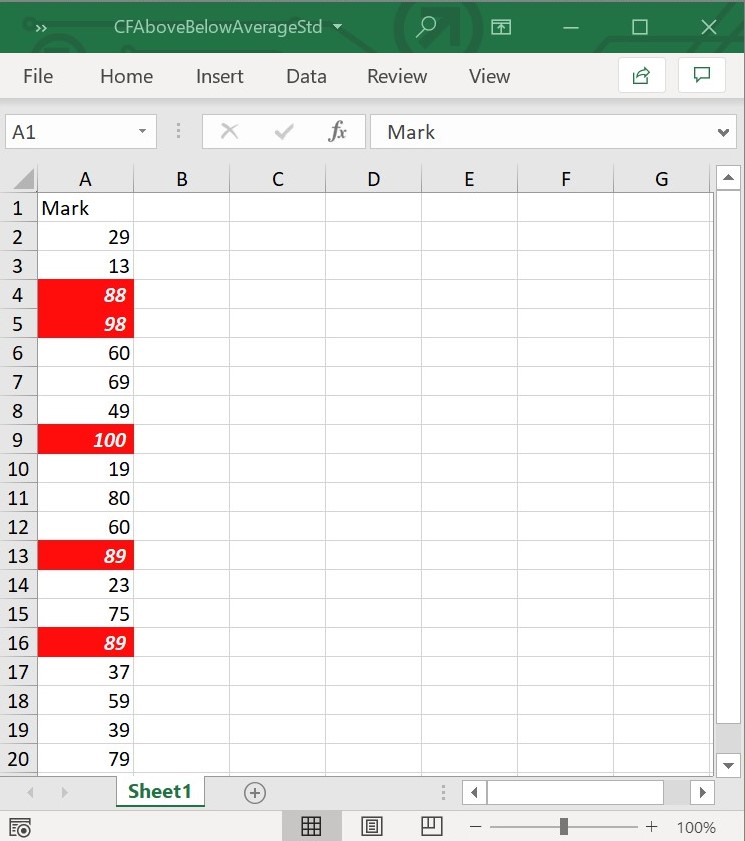
NOTE
AboveBelowAveragestdDevValuecan be applied only if theaverageTypeisaboveStdDevorbelowStdDev. ThestdDevValuevalue should be in a range between 1 and 3.
Advanced Conditional Format Types
In conjunction with basic conditional formatting, the new formatting visualizations such as Color Scales, Icon Sets and Data Bars, are supported in Flutter XlsIO.
Color Scales let you create visual effects in your data to see how the value of a cell is compared with the values in a range of cells. A color scale uses cell shading, as opposed to bars, to communicate relative values, beyond the relative size of the value of a cell.
Creation of color scales and its formatting rules using the ColorScale class in Flutter XlsIO is illustrated as follows.
//Create color scales for the data in specified range
final ConditionalFormats conditionalFormats =
sheet.getRangeByName('B1:B11').conditionalFormats;
final ConditionalFormat conditionalFormat = conditionalFormats.addCondition();
conditionalFormat.formatType = ExcelCFType.colorScale;
final ColorScale colorScale = conditionalFormat.colorScale!;
//Sets 3 - color scale
colorScale.setConditionCount(3);
//Set format color for colorscale by hexa decimal.
colorScale.criteria[0].formatColor = '#2C36F6';
colorScale.criteria[0].type = ConditionValueType.lowestValue;
colorScale.criteria[0].value = '0';
//Set format color for colorscale by RGB values.
colorScale.criteria[1].formatColorRgb = Color.fromARGB(255, 200, 20, 100);
colorScale.criteria[1].type = ConditionValueType.percentile;
colorScale.criteria[1].value = '50';
//Set format color for colorscale by hexa decimal.
colorScale.criteria[2].formatColor = '#F06506';
colorScale.criteria[2].type = ConditionValueType.highestValue;
colorScale.criteria[2].value = '0';Icon Sets
Icon sets present data in three to five categories that are distinguished by a threshold value. Each icon represents a range of values and each cell is annotated with the icon that represents that range.
Icon sets can be created and customized in Flutter XlsIO as follows.
//Create icon sets for the data in specified range
final ConditionalFormats conditionalFormats = sheet.getRangeByName('C1:C11').conditionalFormats;
final ConditionalFormat conditionalFormat = conditionalFormats.addCondition();
conditionalFormat.formatType = ExcelCFType.iconSet;
final IconSet iconSet = conditionalFormat.iconSet!;
//Apply three symbols icon and hide the data in the specified range
iconSet.iconSet = ExcelIconSetType.threeSymbols;
iconSet.iconCriteria[1].type = ConditionValueType.percent;
iconSet.iconCriteria[1].value = "50";
iconSet.iconCriteria[2].type = ConditionValueType.percent;
iconSet.iconCriteria[2].value = "50";
iconSet.showIconOnly = true;Custom Icon Sets
You can customize the icon set by changing the IconSet and Index properties for each icon criteria.
Custom Icon sets can be created and customized in Flutter XlsIO as follows.
// Create a new Excel Document.
final Workbook workbook = Workbook();
// Accessing sheet via index.
final Worksheet sheet = workbook.worksheets[0];
sheet.getRangeByName('A1').setNumber(125);
sheet.getRangeByName('A2').setNumber(279);
sheet.getRangeByName('A3').setNumber(42);
sheet.getRangeByName('A4').setNumber(384);
sheet.getRangeByName('A5').setNumber(129);
sheet.getRangeByName('A6').setNumber(212);
sheet.getRangeByName('A7').setNumber(131);
sheet.getRangeByName('A8').setNumber(230);
//Create iconset for the data in specified range.
final ConditionalFormats conditionalFormats =
sheet.getRangeByName('A1:A10').conditionalFormats;
final ConditionalFormat conditionalFormat = conditionalFormats.addCondition();
//Set FormatType as IconSet.
conditionalFormat.formatType = ExcelCFType.iconSet;
final IconSet iconSet = conditionalFormat.iconSet!;
//Set conditions for IconCriteria.
iconSet.iconSet = ExcelIconSetType.threeFlags;
final IconConditionValue iconValue1 = iconSet.iconCriteria[0] as IconConditionValue;
iconValue1.iconSet = ExcelIconSetType.fiveBoxes;
iconValue1.index = 3;
iconValue1.type = ConditionValueType.percent;
iconValue1.value = '25';
iconValue1.operator = ConditionalFormatOperator.greaterThan;
final IconConditionValue iconValue2 = iconSet.iconCriteria[1] as IconConditionValue;
iconValue2.iconSet = ExcelIconSetType.threeSigns;
iconValue2.index = 2;
iconValue2.type = ConditionValueType.percent;
iconValue2.value = '50';
iconValue2.operator = ConditionalFormatOperator.greaterThan;
final IconConditionValue iconValue3 = iconSet.iconCriteria[2] as IconConditionValue;
iconValue3.iconSet = ExcelIconSetType.fourRating;
iconValue3.index = 0;
iconValue3.type = ConditionValueType.percent;
iconValue3.value = '75';
iconValue3.operator = ConditionalFormatOperator.greaterThan;
final List<int> bytes = workbook.saveSync();
File('CustomIconSet.xlsx').writeAsBytes(bytes);
workbook.dispose();Data Bars
Here, the values in each of the selected cells are compared, and a data bar is drawn in each cell representing the value of that cell relative to the other cells in the selected range. This bar provides a clear visual cue for users, making it easier to pick out larger and smaller values in a range.
This can be set and manipulated using the DataBar class as follows.
//Create data bars for the data in specified range.
final ConditionalFormats conditionalFormats = sheet.getRangeByName('D1:D11').conditionalFormats;
final ConditionalFormat conditionalFormat = conditionalFormats.addCondition();
conditionalFormat.formatType = ExcelCFType.dataBar;
final DataBar dataBar = conditionalFormat.dataBar!;
//Set the constraints
dataBar.minPoint.type = ConditionValueType.lowestValue;
dataBar.maxPoint.type = ConditionValueType.highestValue;
//Set color for DataBar by hexa decimal.
dataBar.barColor = '#FF7C80';
//Hide the data bar values
dataBar.showValue = false;
// set databar as border.
dataBar.hasBorder = true;
// Set Gradient fill to false.
dataBar.hasGradientFill = false;
//Set Bar Axis Position.
dataBar.dataBarAxisPosition = DataBarAxisPosition.middle;
//Set Bar Direction
dataBar.dataBarDirection = DataBarDirection.rightToLeft;
//Set Negative Border color for DataBar in hexa value.
dataBar.negativeBorderColor = '#ED7D31';
//Set Negative Bar color for DataBar in hexa value.
dataBar.negativeFillColor = '#013461';
//Set BarAxis color for DataBar in hexa value.
dataBar.barAxisColor = '#FFDD12';
//Set Border color for DataBar in hexa value.
dataBar.borderColor = '#12DD01';
//Set bar color for DataBar by RGB values.
dataBar.barColorRgb = Color.fromARGB(255, 200, 13, 145);
//Set Negative Border color for DataBar by RGB values.
dataBar.negativeBorderColorRgb = Color.fromARGB(255, 200, 130, 0);
// Set Negative Bar color for DataBar by RGB values.
dataBar.negativeFillColorRgb = Color.fromARGB(230, 201, 230, 100);
// Set BarAxis color for DataBar by RGB values.
dataBar.barAxisColorRgb = Color.fromARGB(255, 134, 44, 224);
//Set Border color for DataBar by RGB values.
dataBar.borderColorRgb = Color.fromARGB(245, 45, 244, 230);The below code example show how to use the advanced conditional formats such as Color Scale, Icon set and DataBar in Flutter XlsIO.
// Create a new Excel Document.
final Workbook workbook = Workbook();
// Accessing sheet via index.
final Worksheet sheet = workbook.worksheets[0];
sheet.getRangeByName('A1').setText('Name');
sheet.getRangeByName('A2').setText('Andy');
sheet.getRangeByName('A3').setText('Jim');
sheet.getRangeByName('A4').setText('Zuke');
sheet.getRangeByName('A5').setText('Mark');
sheet.getRangeByName('A6').setText('Steve');
sheet.getRangeByName('A7').setText('Shan');
sheet.getRangeByName('A8').setText('John');
sheet.getRangeByName('A9').setText('Anne');
sheet.getRangeByName('A10').setText('Jessi');
sheet.getRangeByName('A11').setText('Olive');
sheet.getRangeByName('B1').setText('Mark-1');
sheet.getRangeByName('B2').setNumber(35);
sheet.getRangeByName('B3').setNumber(41);
sheet.getRangeByName('B4').setNumber(84);
sheet.getRangeByName('B5').setNumber(10);
sheet.getRangeByName('B6').setNumber(100);
sheet.getRangeByName('B7').setNumber(37);
sheet.getRangeByName('B8').setNumber(20);
sheet.getRangeByName('B9').setNumber(46);
sheet.getRangeByName('B10').setNumber(87);
sheet.getRangeByName('B11').setNumber(22);
sheet.getRangeByName('C1').setText('Mark-2');
sheet.getRangeByName('C2').setNumber(45);
sheet.getRangeByName('C3').setNumber(78);
sheet.getRangeByName('C4').setNumber(67);
sheet.getRangeByName('C5').setNumber(100);
sheet.getRangeByName('C6').setNumber(89);
sheet.getRangeByName('C7').setNumber(67);
sheet.getRangeByName('C8').setNumber(37);
sheet.getRangeByName('C9').setNumber(40);
sheet.getRangeByName('C10').setNumber(88);
sheet.getRangeByName('C11').setNumber(35);
sheet.getRangeByName('D1').setText('Mark-3');
sheet.getRangeByName('D2').setNumber(39);
sheet.getRangeByName('D3').setNumber(78);
sheet.getRangeByName('D4').setNumber(22);
sheet.getRangeByName('D5').setNumber(89);
sheet.getRangeByName('D6').setNumber(54);
sheet.getRangeByName('D7').setNumber(94);
sheet.getRangeByName('D8').setNumber(48);
sheet.getRangeByName('D9').setNumber(65);
sheet.getRangeByName('D10').setNumber(15);
sheet.getRangeByName('D11').setNumber(70);
//Create color scales for the data in specified range
ConditionalFormats conditionalFormats =
sheet.getRangeByName('B1:B11').conditionalFormats;
ConditionalFormat conditionalFormat = conditionalFormats.addCondition();
conditionalFormat.formatType = ExcelCFType.colorScale;
final ColorScale colorScale = conditionalFormat.colorScale!;
//Sets 3 - color scale
colorScale.setConditionCount(3);
//Set format color for colorscale by hexa decimal.
colorScale.criteria[0].formatColor = '#2C36F6';
colorScale.criteria[0].type = ConditionValueType.lowestValue;
colorScale.criteria[0].value = '0';
//Set format color for colorscale by RGB values.
colorScale.criteria[1].formatColorRgb = Color.fromARGB(255, 200, 20, 100);
colorScale.criteria[1].type = ConditionValueType.percentile;
colorScale.criteria[1].value = '50';
//Set format color for colorscale by hexa decimal.
colorScale.criteria[2].formatColor = '#F06506';
colorScale.criteria[2].type = ConditionValueType.highestValue;
colorScale.criteria[2].value = '0';
//Create icon sets for the data in specified range.
conditionalFormats = sheet.getRangeByName('C1:C11').conditionalFormats;
conditionalFormat = conditionalFormats.addCondition();
conditionalFormat.formatType = ExcelCFType.iconSet;
final IconSet iconSet = conditionalFormat.iconSet!;
//Apply three symbols icon and hide the data in the specified range.
iconSet.iconSet = ExcelIconSetType.threeSymbols;
iconSet.iconCriteria[1].type = ConditionValueType.percent;
iconSet.iconCriteria[1].value = "40";
iconSet.iconCriteria[2].type = ConditionValueType.percent;
iconSet.iconCriteria[2].value = "80";
iconSet.showIconOnly = true;
//Create data bars for the data in specified range.
conditionalFormats = sheet.getRangeByName('D1:D11').conditionalFormats;
conditionalFormat = conditionalFormats.addCondition();
conditionalFormat.formatType = ExcelCFType.dataBar;
final DataBar dataBar = conditionalFormat.dataBar!;
//Set the constraints
dataBar.minPoint.type = ConditionValueType.lowestValue;
dataBar.maxPoint.type = ConditionValueType.highestValue;
//Set color for DataBar by RGB values.
dataBar.barColorRgb = Color.fromARGB(255, 244, 180, 10);
//Hide the data bar values
dataBar.showValue = false;
// save and dispose.
final List<int> bytes = workbook.saveSync();
File('ConditionalFormat.xlsx').writeAsBytes(bytes);
workbook.dispose();The following screenshot represents generated Excel file with advanced conditional format in Flutter XlsIO.
